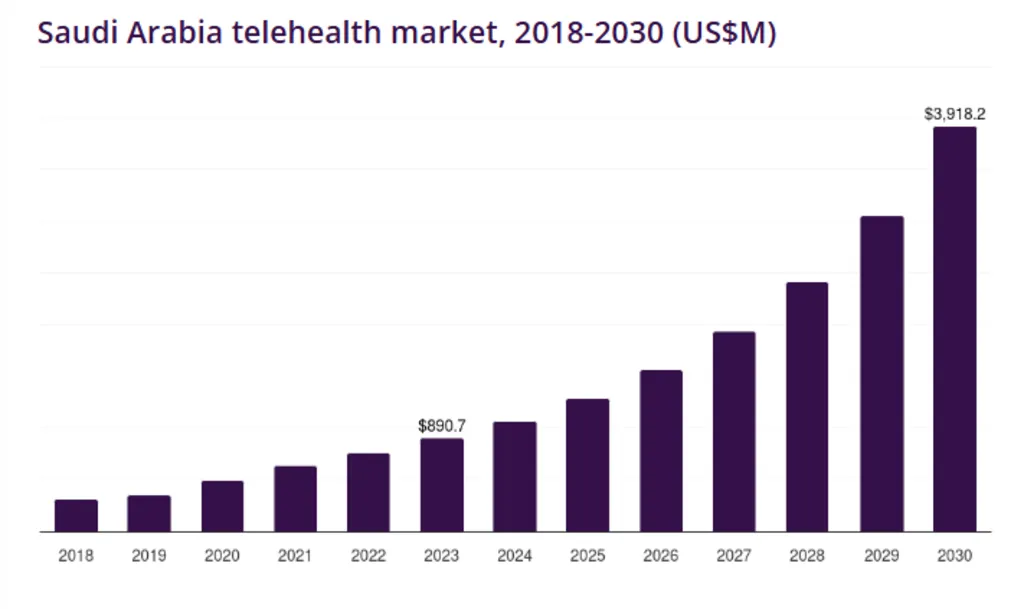Saudi Telehealth Expansion: Market to Hit $3.9B by 2030
Saudi Arabia is rapidly emerging as a digital health powerhouse, with its telehealth sector projected to grow from USD 1.06 billion in 2024 to USD 3.92 billion by 2030. This remarkable 25.1% compound annual growth rate (CAGR) from 2025 to 2030 reflects not only rising demand for virtual care but also the Kingdom’s strategic investments in AI, integrated platforms, and regulatory innovation. The Saudi Telehealth Expansion is more than a market trend—it’s a national transformation aligned with Vision 2030, aiming to deliver inclusive, data-driven healthcare across the country.
This article explores the key drivers behind Saudi Arabia’s telehealth boom, including the dominance of service-based care in 2024, the rapid rise of software solutions, and the pivotal role of Seha Virtual Hospital—the world’s largest virtual care platform. It also examines how government-led initiatives, international partnerships, and regional competition are shaping the Kingdom’s digital health trajectory. From infrastructure to innovation, Saudi Arabia is building a scalable model of virtual care that could redefine healthcare delivery across the Middle East and beyond.

Market to Surge from $1.06B in 2024 to $3.92B by 2030
The Saudi Telehealth Expansion is set to transform the healthcare landscape, with market revenues expected to nearly quadruple in just six years. From USD 1,061.9 million in 2024, the market is forecast to reach USD 3,918.2 million by 2030. This 25.1% CAGR places Saudi Arabia among the fastest-growing telehealth markets globally. While the Kingdom accounted for just 0.9% of global telehealth revenue in 2024, its share is poised to grow as digital health becomes a national priority.
Services Dominate in 2024, But Software Is the Fastest Riser
In 2024, services such as virtual consultations, remote monitoring, and tele-ICU support were the largest contributors to telehealth revenue. However, software is emerging as the most dynamic segment, driven by demand for AI-powered diagnostics, electronic health records, and interoperable care platforms. As hospitals and clinics digitize operations, software will play a critical role in scaling virtual care and improving patient outcomes.
Seha Virtual Hospital: A National Backbone for Virtual Care
A cornerstone of the Saudi Telehealth Expansion is Seha Virtual Hospital, now the largest virtual care platform in the world. It connects 224 hospitals across the Kingdom, offering specialized consultations, remote ICU services, and AI-enhanced diagnostics. This infrastructure has significantly improved access to care in rural and underserved regions, aligning with Vision 2030’s goals of equity and efficiency in healthcare delivery.
Government Innovation and Regulatory Support Fuel Growth
Saudi Arabia’s Ministry of Health has been instrumental in accelerating telehealth adoption. Through regulatory sandboxes, AI integration, and public-private partnerships, the government has created a supportive environment for digital health innovation. These efforts have helped normalize virtual care, shifting it from a pandemic-era necessity to a permanent fixture in the healthcare system.
Regional Competition and Global Collaboration
While the U.S. is expected to remain the global leader in telehealth revenue by 2030, Saudi Arabia is gaining ground in the Middle East. The UAE is projected to lead the regional market with USD 4.83 billion in revenue by 2030, but Saudi Arabia’s strategic focus on infrastructure, innovation, and international collaboration positions it as a formidable contender. Events like the MENA Telehealth and Virtual Care Expo highlight the Kingdom’s growing influence in shaping global digital health standards.
Vision 2030: Anchoring Long-Term Healthcare Transformation
The Saudi Telehealth Expansion is deeply embedded in the Kingdom’s Vision 2030 strategy, which emphasizes economic diversification, innovation, and sustainability. By investing in digital health, Saudi Arabia is not only modernizing its healthcare system but also creating a replicable model for other nations. The integration of AI, virtual platforms, and inclusive care delivery is setting a new standard for what healthcare can look like in the 21st century.
Also Read: Bed Gap to Hit 40K by 2035: Saudi Home Healthcare Rises







